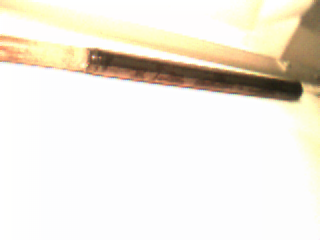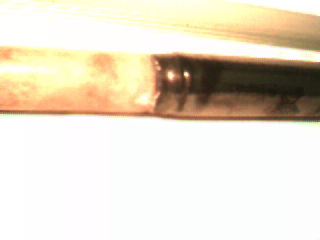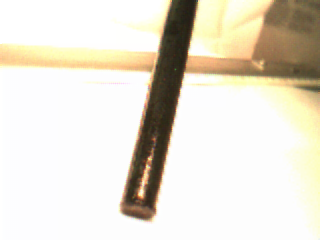| Pages:
1
..
35
36
37
38
39
..
47 |
Picric-A
National Hazard
   
Posts: 796
Registered: 1-5-2008
Location: England
Member Is Offline
Mood: Fuming
|
|
nope, in myn it looks like a black powder attached to it, when i rub it wet it comes off as a graphite like mark on your finger, when dry it seems to
stay on, again like rubbing a pice of pencil lead on the side, only a bit of black comes off...
|
|
|
dann2
International Hazard
    
Posts: 1523
Registered: 31-1-2007
Member Is Offline
Mood: No Mood
|
|
Hi,
Not a hope of this working. The Lead substrate will get attacked from the start and the whole lot will fall apart.
It has been tried many times before my many hopeful Chlorate/Perchlorate makers. You will probably get some Perchlorate to form before the anode
fails but you will get damm all.
Dann2
......and ya need not bother with the Iron either..........LOL
|
|
|
hashashan
Hazard to Others
  
Posts: 255
Registered: 10-10-2006
Member Is Offline
Mood: No Mood
|
|
What do you mean not bother with IRON?
I know a dude that grew a massive anode on Iron substrate
|
|
|
dann2
International Hazard
    
Posts: 1523
Registered: 31-1-2007
Member Is Offline
Mood: No Mood
|
|
I meant using Iron as an an actual current carrying substrate (in a Chlorate or Perchlorate cell). OK as a substrate for a massive anode.
Dann2
|
|
|
chief
National Hazard
   
Posts: 630
Registered: 19-7-2007
Member Is Offline
Mood: No Mood
|
|
Has someone tried this (?) ::
==> since the probloem with the PbO2-Anode is it's mechanical disintegration,
==> why not just put the PbO2-flakes into a cup (that rests at the bottom of the chlorate-cell),
==> and contact this cup, full with the PbO2, somehow ?
So the PbO2 wouldn's "fall" off, since gravitation could not drag it any lower, and the anode could be useful like that ...
For the contacting may be a goughing-rod, insulatat over most of it's path, and only electrically connecting from somewhat within the PbO2-ground,
could suffice (?), like eg. leading the goughing-rod throug a glass-tube down to the PbO2.
Since electrochemical things only appear where the current flows, and the potential is shielded by conductors (as the PbO2), the eletrochemical
reaction would just take place at the surface of the PbO2-bed, shielding the underlying PbO2 nd the graphite as well as the conductivity of the PbO2
allows: The better the conductivity, the better the shielding effect ...
Besides also the graphite, when corroding, just would end up within the PbO2 (contributing to the conductivity somewhat), maybe slowing down the
corrosion-rate too ?
|
|
|
hashashan
Hazard to Others
  
Posts: 255
Registered: 10-10-2006
Member Is Offline
Mood: No Mood
|
|
Well I dont know where to start but my main pioint will be that it is imposible
the reasons would be :
1)water is not vacum, the powder will leave the cup and stay as suspension due to water currents and bubbles forming on the anode and inside it
2) PbO2 is resistant to the conditions in the cell but the powder is inferiour to the single ingot in resistance
3) the electrical resistance of the powdered ande would be enormous, heat will be evolved and once again your anode will just float around
4) graphite will get worn down in an hour once you hit the perchlorate stage
however if you press your anode most of the problems will dissapear.
I dont know how a pressed PbO2 anode will work but AFAIK it also doesnt work
|
|
|
chief
National Hazard
   
Posts: 630
Registered: 19-7-2007
Member Is Offline
Mood: No Mood
|
|
What about this:
==> When ppt. out the KClO3 from the NaClO3-NaCl- electrolyte ::
==> using just KOH instead of KCl, because of its high solubility
Benefit would be to have just to acquire only the KOH, no KCl (with little other usefuleness) necessary. The after-ppt.-electrolyte would then be more
alcalic (affecting the efficiency, as I believe to have read elsewhere), but otherwise not much different from the usual XClO3-manufacturing scheme,
where also someways anyhow an hydroxide-solution is reacted with chlorine ... ???
Do am I not aware of some difficulty ?
|
|
|
chief
National Hazard
   
Posts: 630
Registered: 19-7-2007
Member Is Offline
Mood: No Mood
|
|
Also: Since I didn't find any KOH or KCl until now, but a bag of K2SO4/MgSO4 (70/30), my raw plan is:
==> Mg out as MgCO3, via Soda
==> use the resulting Na2SO4/K2SO4 (70/30) to ppt. out the KClO4, with some loss ..
I don't care too much about the loss, but how is it:
==> Could the electrolyte be re-used (?), containing now also SO3(2-)-ions ?
==> might it even be better to at first not ppt. out the Mg, and thereby have some Mg getting into the reaction, which gives even more soluble
Chlorate than Sodium (http://en.wikipedia.org/wiki/Solubility_table#M), which at the end might give a way to obtain NaClO3 by ppt. out the Mg at last (via carbonate
again)
|
|
|
chief
National Hazard
   
Posts: 630
Registered: 19-7-2007
Member Is Offline
Mood: No Mood
|
|
Report: I have a PbO2-Anode in Service, after only the second attempt to make one:
==> It operates since 24 h, at 10 A, with no loss of material
Was made like that:
==> 13 mm-carbon rod (welding), copper plated
==> was hung into the Pb(NO3)2 -Bath, (_little_ acidic, more than 200 g/l, temperature 10-20 [Cels]
==> initially 60 mA/cm^2, after 5 h down to 20, for 12 more h
==> every 3 h PbCO3 was added, just so much as would quickly dissolve on it's path down the vessel (cola-bottle, ca. 1.2 l volume, Kathode:
copper-wire (2 mm diameter, as spiral, 0.75 winding/cm))
Although th finished Anode lookes suspicious (pin-needle-head-like "pinholes") it holds and does not corrode ! After 24 h maybe its not that great,
but at least it can be called a "hardened" graphite-electrode !
The welding-graphite-electrode was copper-plated and hung into the bath as it was, with the copper. The copper dissolved during the initial 1 h, then
the PbO2 took its place. Thereby maybe I just re-used the proper-graphite-preparation (for plating) that was applied by the manufacturer (who plated
the copper).
... and the anode was rotated during the plating, but not at 1000 rpm, just every 10 seconds a slight 0.3-seconds start to the drilling engine, in
which it was mounted. Only enough movement to keep the bath stirred and to potentially shake off larger bubbles.
[Edited on 19-9-2008 by chief]
[Edited on 19-9-2008 by chief]
|
|
|
tentacles
Hazard to Others
  
Posts: 191
Registered: 11-11-2007
Member Is Offline
Mood: No Mood
|
|
I've been considering purchasing one of the commercial MMO anodes and attempting to plate it with PbO2, as an experiment. The 2x6" ones are only $49
from americanpyrosupply.com so it wouldn't be a gigantic loss if it was a failure. Thoughts from others? I've heard these anodes CAN make perc but
likely erode faster than one would like. The PbO2 coating over top might work well, similar to how dann's PbO2 over ATO has been working out so well.
|
|
|
chief
National Hazard
   
Posts: 630
Registered: 19-7-2007
Member Is Offline
Mood: No Mood
|
|
But welding-rods (13 mm diameter, 40 cm length, copper-plated) cost below 1 EUR each ! Thats cheaper, and after the 50 EUR for a MMO-electrode
probably by variation of the parameters anyone can get around using the graphite, and with an increasing success-rate !
|
|
|
hashashan
Hazard to Others
  
Posts: 255
Registered: 10-10-2006
Member Is Offline
Mood: No Mood
|
|
cheif you are right, however the problem will begin as soon as a single pin hole will reach the substrate, graphite erodes extremely fast when you are
trying to make perchlorate with it, i mean it will be a matter of several hours untill your anode will become absolutely useless.
The only test you can make is to try to make perchlorate with it with low chloride amounts, then you will know if it functions or not.
the fact that it is working in a NaCl solution doesnt say anything yet
|
|
|
dann2
International Hazard
    
Posts: 1523
Registered: 31-1-2007
Member Is Offline
Mood: No Mood
|
|
Hello,
Ye old Graphite substrate Lead Dioxide anode....AGAIN!! 
My two cents worth on Graphite substrate anodes:
Use a thick coating of Lead Dioxide, at least three mm, better to use 5mm.
Keep plating conditions as professional as possible (two big tanks, steady pH, steady Lead Ion concentration, use surfactant, etc) so that the coating
is good.
Use high grade of Graphite. Gouging rods  (if you can get them to work that
would be great) (if you can get them to work that
would be great)
Many have made the Graphite Substrate LD Anode,
Few have actually got the (damm) thing to work for long.
I think that plating an MMO would be interesting to see if it would work (don't see why not). US patent 4444642 says it can be done, it is the only
patent I know that states it can be done, but there are many types of MMO. When LD plating wears off (hopefully after much Perchlorate has been
made), just plate on more LD again.
If the LD plating fails quickly (ie. the anode does not work at all) you always still have your MMO anode for Chlorate etc. I would not think that
plating with LD would actually damage the MMO coating. There would be no loss at all from trying!!! (Go for it tentacles, grab the bull by the
horns!!! (as it were), it's the only way we will find out.
Coating Titanium with Tin Oxide is a bit of a pain, especially if you do not have any SnCl4 (Stannic Chloride, anhydrous or otherwise).
@Chief
You might be tired by the time you have all the different parameters tried. The one dollar Gouging rods are cheap but what about all the chemicals,
time etc.
Graphite substrate LD anodes DO work. There were used by Kerr/McGee? to make kilo tons of Perchlorate (See US 2,945,791). The amateur has, by and
large, failed to get this type of anode to work. It can be done though.
@ Tentacles
Where did you read/hear that MMO will make Perchlorate?
JP Smith has suggested that Pt Oxide (not a very usual Oxide type in MMO as far as I know) in an MMO anode may/would make Perk.
________________________________
Edit:
Patent for Perchlorate MMO Anode.
US Patent 4267025 depicts an MMO anode made from Ti, Platinum Group Oxides + Tin Oxide that is suitable for Perchlorate production.
______________________________
Really must crank up a cell with LD anode again soon.
Cheers,
Dann2
[Edited on 21-9-2008 by dann2]
|
|
|
chief
National Hazard
   
Posts: 630
Registered: 19-7-2007
Member Is Offline
Mood: No Mood
|
|
I don't want to brag around, but I just have to:
==> now, with the above setup, I also made a very dense and smooth anode, that has only 1 pinhole, and gives no black color when wiping it
This time the electrolyte was thicker, and I had plenty of PbCO3 to throw in, for neutralizing most of the acid.
|
|
|
DJF90
International Hazard
    
Posts: 2266
Registered: 15-12-2007
Location: At the bench
Member Is Offline
Mood: No Mood
|
|
PICTURES PLEASE 
|
|
|
chief
National Hazard
   
Posts: 630
Registered: 19-7-2007
Member Is Offline
Mood: No Mood
|
|
Sorry for the lousy quality of the webcam; here 3 images, each as attachment (since img-code has to name a url):

|
|
|
chief
National Hazard
   
Posts: 630
Registered: 19-7-2007
Member Is Offline
Mood: No Mood
|
|
the next:

|
|
|
chief
National Hazard
   
Posts: 630
Registered: 19-7-2007
Member Is Offline
Mood: No Mood
|
|
and:

|
|
|
chief
National Hazard
   
Posts: 630
Registered: 19-7-2007
Member Is Offline
Mood: No Mood
|
|
And it weigths 77 gm more than another of the same sort (but with the original copper-coating in place)
The plating lasted maybe 6 hours,
==> current was 4.5 A,
==> current-density anbout 65 mA/cm^2 at the start,
==> than diminishing with the growing of the layer (maybe 2 mm thick)
|
|
|
dann2
International Hazard
    
Posts: 1523
Registered: 31-1-2007
Member Is Offline
Mood: No Mood
|
|
Hello Cheif,
Patent here:
http://www.freepatentsonline.com/4702805.html
that mentions Sulphate in the solution.
May be of some use regarding what you asked up a few posts.
Dann2
|
|
|
gregxy
Hazard to Others
  
Posts: 421
Registered: 26-5-2006
Member Is Offline
Mood: No Mood
|
|
There were some hints at this earlier but why not try the
following:
1. Get a cylindrical plastic container with a flat bottom.
2. Get a Pt or Pt plated wire
3. Drill a hole in the bottom of the plastic container the same dia as the wire.
4. Inset the wire through the hole and coil it to form a flat spiral in the bottom of the container.
5. seal around the wire with some form of glue.
6. Put about 2cm of PbO2 into the container.
7. Press the PbO2 to form a solid mass.
8. Plate additional PbO2 into the mass if needed.
This would allow you to create a truely massive electrode.
In addition the vulnerable connections are protected and any
PbO2 that flakes off should just stay in place.
It has a final advantage that the Cl2 that is generated will bubble up to the cathode, (which could be just a flat metal disk 1cm above the anode.)
|
|
|
tentacles
Hazard to Others
  
Posts: 191
Registered: 11-11-2007
Member Is Offline
Mood: No Mood
|
|
I think that if you can afford a piece of Pt wire that will handle the kind of current we're looking for (just as a simple conductor) then you don't
need the PbO2 in the equation. Also, I have concerns about the oxygen and chlorine evolving preferentially on the Pt, when the solution inevitably
penetrated the cracks and pitting.
Using a Pt plated Ti mesh anode as a substrate for PbO2 might work, though... but you're talking about a $100+ substrate. That makes a good anode by
itself.
Please, go read that patent about pressed PbO2 anodes. It's getting kind of old, everyone always dredges that up. I'm guilty of it as well. You MUST
plate over the pressed PbO2 - period. The powered stuff is the wrong phase. It crumbles. You have to press it (with a composite binder) at thousands
of PSI. And even then, you STILL need a perfect PbO2 plating process, or a substrate that can handle the cell chemistry as anode.
Also, that advantage of Cl2 and O2 bubbling up.. also means that every bubble under the cathode is obstructing your electrons.
|
|
|
dann2
International Hazard
    
Posts: 1523
Registered: 31-1-2007
Member Is Offline
Mood: No Mood
|
|
Hello,
I seen the attached paper referenced many time but never actuall read it. It the original spinning Graphite substrate anode procedure form the
Bulletin of the Chemical Society of Japan. It is available freely from their web site.
Interesting to note that they used Dichromate in a Chlorate cell and still got an OK CE. Guess Dichromate is not totally detrimental to CE in a Lead
Dioxide anode Chlorate cell.
Attachment: Bulletin of CS Japan.pdf (748kB)
This file has been downloaded 1730 times
|
|
|
dann2
International Hazard
    
Posts: 1523
Registered: 31-1-2007
Member Is Offline
Mood: No Mood
|
|
Hello,
A paper here from the Bureau of Mines of a Ti substrate LD Anode from http://www.hathitrust.org/.
It is for electrowinning metals. Not much in it, it seems that we have not seen before. It uses Ti with holes drilled in it for the substrate. It also
uses a high level of Nitric acid in the plating bath. Happy reading.
Dann2
Attachment: Bureau of Mines LD Anode.pdf (845kB)
This file has been downloaded 1045 times
|
|
|
tentacles
Hazard to Others
  
Posts: 191
Registered: 11-11-2007
Member Is Offline
Mood: No Mood
|
|
Very minor addition to the gene pool here, turns out nonionic surfactant is dead easy to come by, simply purchase Jet Dry rinse aid. 1-5% c10-16
ethoxylated alcohols... CAS 68002-97-1. No idea if this would be suitable for LD plating but it could be a very accessible source.
|
|
|
| Pages:
1
..
35
36
37
38
39
..
47 |